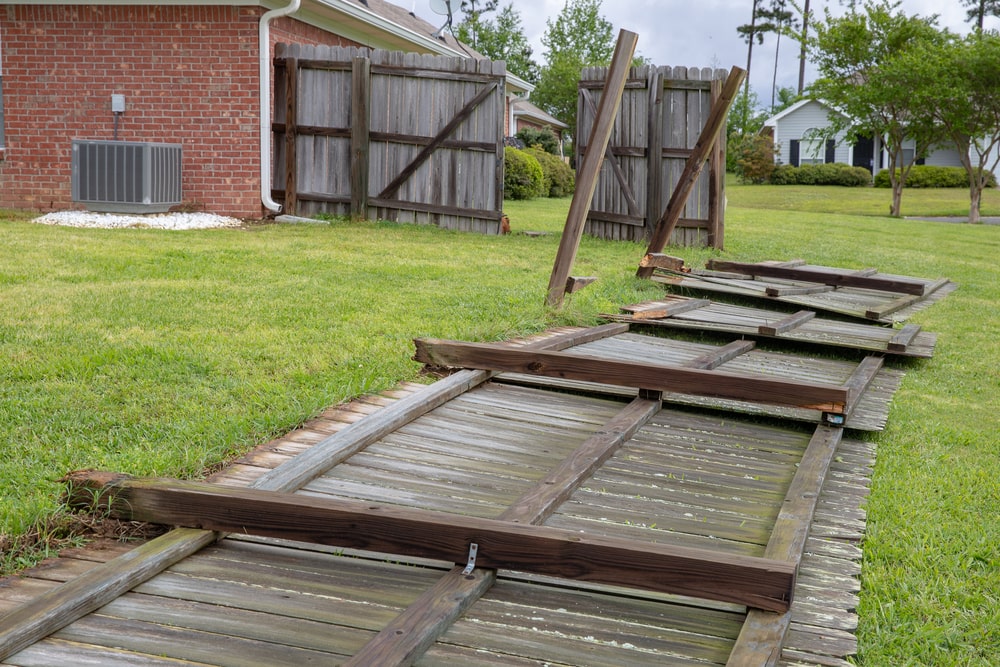So you’ve had the same fence in your yard for a long time. You’ve had it for so long, you can’t even remember how long it’s been there. If you start to notice that your trusty old backyard fence is looking a little too shabby, it might be time to install a new one.
There are a few red flags to watch out for in your fence. If you notice significant damage and wear on your fence, you’re due for a fence replacement. Fence damage comes in many forms, including board damage, panel wear, mesh wear, insect damage, sagging, and discoloration. Corrosion is caused by age as well as weather events and sunlight. In this article, we’ll discuss the different types of fence damage, what they’re caused by, and how to spot them.
Here are the signs that you need a fence replacement:
Damage to the boards, panels or mesh
If you notice significant damage to the boards, panels, or mesh, it’s time to begin looking for a replacement fence. Damage may occur as a result of harsh weather conditions like storms, tornados, and flooding. If your fence is damaged from a storm or other natural event, your insurance policy might cover it. If you have had a fence for more than 15 years, it is likely suffering natural wear from old age. The kind of damage your fence experiences will depend on the material it’s composed of. Wood fences tend to deteriorate more quickly and can develop holes, especially if the wood is untreated. Treated wood prevents wear and tear and extends the fence’s lifespan.
Chain link mesh fences are particularly prone to rust. Steel chain-link fencing, including those coated with polyvinyl chloride (PVC), can deteriorate in as little as five years. Chain link fences are most prone to rust in warm, coastal locations where humidity levels are high.
Vinyl panels corrode more slowly than other types of panels. However, they can still be damaged by extreme weather events such as sudden floods or impacts.
Heavy rainfall can cause lasting damage to your fences, especially if it’s made of wood. Heavy winds can topple over the panels and while excess water from rainfall can soak a fence through. Fences in rainy, humid climates like the Southeast U.S. can experience wear over time as the humidity leads to rot. When your fence starts to rot, fungi can grow inside the wood and leave unattractive, spongy nodes on your board panels.
Insect damage
Everyone knows that termites eat up wood. But what about carpenter ants, wood boring beetles, and powder post beetles? If you’ve never heard of these insects before, you might hear of them now if your fence has insect damage. They are the insects most likely to cause damage to wooden fences. While you might not spot the insects themselves, you can see the visible traces they leave behind. Small holes and bores are signs of insect damage. Powder post beetles leave clots of powder next to their nests, while carpenter ants build their nests in between boards. If you notice any of these pesky traces on your fence, it’s probably time for a replacement.
Sagging
After years of wear and weather impact, it’s common for fences to experience sagging. Sagging occurs when posts get loose from their cement foundations, tilting the entire fence toward the side or bent over producing a “sagging” effect.
Even pressure-treated wood experiences sagging over time. Wooden fences in humid climates are especially prone to sagging because the wood soaks up the moisture and destabilizes the base of the fence. Lawn sprinklers also give off excess moisture which leads to sagging.
If you have an older fence experience noticeable sagging, you might want to consider getting a brand new fence.
Discoloration
Discoloration is one of the first signs of weather damage. While paint naturally chips and fades color over time, weather conditions can cause more serious damage. Over time, storms and heavy rainfall corrode the coloring of your fence. Prolonged sunlight exposure can also lead to discoloration and leave the fence a paler, faded color. If you live in a sunny climate, you’ll also want to watch out for sunspots, which are small faded, white-colored dots on the wood caused by sun exposure.
Guide to Fence Replacements
If you notice your fence showing any of the above signs of damage, you should consider a fence replacement. Weigh the cost of repairs versus a replacement. If your fence is only five years old, it might be worth it to pay for repairs and increase the lifespan of the fence. However, if your fence is ten or fifteen years old, the damage may be irreparable or the costs of repair too high to justify not buying a new one.
If you decide the get a full fence replacement, Fencing Direct sells materials at wholesale prices. See all products here.
Frequently Asked Questions (FAQs)
How much does a fence replacement cost?
The price of a new fence varies depending on the material, style, and size. On average, fence installation costs $13 to $25 per linear foot. When you pay to install a fence, you are paying not only for the fence itself, but also for the labor required. Chain-link fences are on the lower-end, natural wood is mid-range, and vinyl is more expensive. Pressure-treated wood costs more than non-treated wood but can help your fence last years longer.
Should I talk to my neighbor about a fence replacement?
Whoever’s property the fence is on owns the fence. However, if you want to replace a fence that is visible from your neighbor’s yard or property, you may want to discuss it with them. Consider the color and style you want, and ask your neighbor if they’d like to pay for a portion of the fence. If you split the cost, discuss staining and if your neighbor wants their side of the fence stained.


